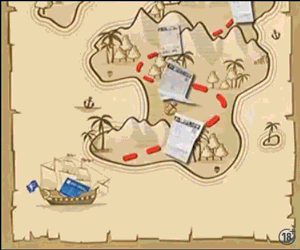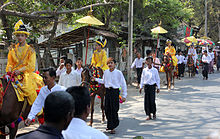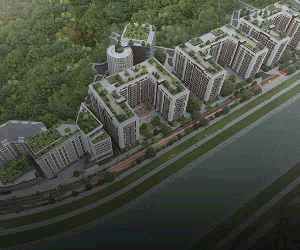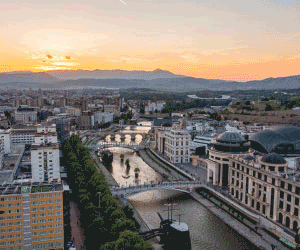Myanmar,[d] officially the Republic of the Union of Myanmar[e] and also referred to as Burma (the official English form until 1989), is a country in northwest Southeast Asia. It is the largest country by area in Mainland Southeast Asia and has a population of about 55 million. It is bordered by India and Bangladesh to its northwest, China to its northeast, Laos and Thailand to its east and southeast, and the Andaman Sea and the Bay of Bengal to its south and southwest. The country’s capital city is Naypyidaw, and its largest city is Yangon (formerly Rangoon).[16] Early civilisations in the area included the Tibeto-Burman-speaking Pyu city-states in Upper Myanmar and the Mon kingdoms in Lower Myanmar.[17] In the 9th century, the Bamar people entered the upper Irrawaddy valley, and following the establishment of the Pagan Kingdom in the 1050s, the Burmese language and culture and Theravada Buddhism slowly became dominant in the country. The Pagan Kingdom fell to Mongol invasions, and several warring states emerged. In the 16th century, reunified by the Taungoo dynasty, the country became the largest empire in the history of Southeast Asia for a short period.[18] The early 19th-century Konbaung dynasty ruled over an area that included modern Myanmar and briefly controlled Assam, the Lushai Hills, and Manipur as well. The British East India Company seized control of the administration of Myanmar after three Anglo-Burmese Wars in the 19th century, and the country became a British colony. After a brief Japanese occupation, Myanmar was reconquered by the Allies. On 4 January 1948, Myanmar declared independence under the terms of the Burma Independence Act 1947.
Archaeological evidence shows that Homo erectus lived in the region now known as Myanmar as early as 750,000 years ago, with no more erectus finds after 75,000 years ago.[55] The first evidence of Homo sapiens is dated to about 25,000 BP with discoveries of stone tools in central Myanmar.[56] Evidence of Neolithic age domestication of plants and animals and the use of polished stone tools dating to sometime between 10,000 and 6,000 BCE has been discovered in the form of cave paintings in Padah-Lin Caves.[57] The Bronze Age arrived c. 1500 BCE when people in the region were turning copper into bronze, growing rice and domesticating poultry and pigs; they were among the first people in the world to do so.[58] Human remains and artefacts from this era were discovered in Monywa District in the Sagaing Region.[59] The Iron Age began around 500 BCE with the emergence of iron-working settlements in an area south of present-day Mandalay.[60] Evidence also shows the presence of rice-growing settlements of large villages and small towns that traded with their surroundings as far as China between 500 BCE and 200 CE.[61] Iron Age Burmese cultures also had influences from outside sources such as India and Thailand, as seen in their funerary practices concerning child burials. This indicates some form of communication between groups in Myanmar and other places, possibly through trade.[62] Early city-states Main articles: Pyu city-states and Mon kingdoms Around the second century BCE the first-known city-states emerged in central Myanmar. The city-states were founded as part of the southward migration by the Tibeto-Burman-speaking Pyu people, the earliest inhabitants of Myanmar of whom records are extant, from present-day Yunnan.[63] The Pyu culture was heavily influenced by trade with India, importing Buddhism as well as other cultural, architectural and political concepts, which would have an enduring influence on later Burmese culture and political organisation.[64] By the 9th century, several city-states had sprouted across the land: the Pyu in the central dry zone, Mon along the southern coastline and Arakanese along the western littoral. The balance was upset when the Pyu came under repeated attacks from Nanzhao between the 750s and the 830s. In the mid-to-late 9th century the Bamar people founded a small settlement at Bagan. It was one of several competing city-states until the late 10th century, when it grew in authority and grandeur.[65] Pagan gradually grew to absorb its surrounding states until the 1050s–1060s when Anawrahta founded the Pagan Kingdom, the first ever unification of the Irrawaddy valley and its periphery. In the 12th and 13th centuries, the Pagan Empire and the Khmer Empire were two main powers in mainland Southeast Asia.[66] The Burmese language and culture gradually became dominant in the upper Irrawaddy valley, eclipsing the Pyu, Mon and Pali norms[clarification needed] by the late 12th century.[67] Theravada Buddhism slowly began to spread to the village level, although Tantric, Mahayana, Hinduism, and folk religion remained heavily entrenched. Pagan’s rulers and wealthy built over 10,000 Buddhist temples in the Pagan capital zone alone. Repeated Mongol invasions in the late 13th century toppled the four-century-old kingdom in 1287.[67]



Pagan gradually grew to absorb its surrounding states until the 1050s–1060s when Anawrahta founded the Pagan Kingdom, the first ever unification of the Irrawaddy valley and its periphery. In the 12th and 13th centuries, the Pagan Empire and the Khmer Empire were two main powers in mainland Southeast Asia.[66] The Burmese language and culture gradually became dominant in the upper Irrawaddy valley, eclipsing the Pyu, Mon and Pali norms[clarification needed] by the late 12th century.[67] Theravada Buddhism slowly began to spread to the village level, although Tantric, Mahayana, Hinduism, and folk religion remained heavily entrenched. Pagan’s rulers and wealthy built over 10,000 Buddhist temples in the Pagan capital zone alone. Repeated Mongol invasions in the late 13th century toppled the four-century-old kingdom in 1287.[67] Political unification returned in the mid-16th century, through the efforts of Taungoo, a former vassal state of Ava. Taungoo’s young, ambitious King Tabinshwehti defeated the more powerful Hanthawaddy in the Toungoo–Hanthawaddy War. His successor Bayinnaung went on to conquer a vast swath of mainland Southeast Asia including the Shan states, Lan Na, Manipur, Mong Mao, the Ayutthaya Kingdom, Lan Xang and southern Arakan. However, the largest empire in the history of Southeast Asia unravelled soon after Bayinnaung’s death in 1581, completely collapsing by 1599. Ayutthaya seized Tenasserim and Lan Na, and Portuguese mercenaries established Portuguese rule at Thanlyin (Syriam). The dynasty regrouped and defeated the Portuguese in 1613 and Siam in 1614. It restored a smaller, more manageable kingdom, encompassing Lower Myanmar, Upper Myanmar, Shan states, Lan Na and upper Tenasserim. The restored Toungoo kings created a legal and political framework whose basic features continued well into the 19th century. The crown completely replaced the hereditary chieftainships with appointed governorships in the entire Irrawaddy valley and greatly reduced the hereditary rights of Shan chiefs. Its trade and secular administrative reforms built a prosperous economy for more than 80 years. From the 1720s onward, the kingdom was beset with repeated Meithei raids into Upper Myanmar and a nagging rebellion in Lan Na. In 1740, the Mon of Lower Myanmar founded the Restored Hanthawaddy Kingdom. Hanthawaddy forces sacked Ava in 1752, ending the 266-year-old Toungoo Dynasty. After the fall of Ava, the Konbaung–Hanthawaddy War involved one resistance group under Alaungpaya defeating the Restored Hanthawaddy, and by 1759 he had reunited all of Myanmar and Manipur and driven out the French and the British, who had provided arms to Hanthawaddy. By 1770, Alaungpaya’s heirs had subdued much of Laos and fought and won the Burmese–Siamese War against Ayutthaya and the Sino-Burmese War against Qing China.[71] With Burma preoccupied by the Chinese threat, Ayutthaya recovered its territories by 1770 and went on to capture Lan Na by 1776. Burma and Siam went to war until 1855, but all resulted in a stalemate, exchanging Tenasserim (to Burma) and Lan Na (to Ayutthaya). Faced with a powerful China and a resurgent Ayutthaya in the east, King Bodawpaya turned west, acquiring Arakan (1785), Manipur (1814) and Assam (1817). It was the second-largest empire in Burmese history but also one with a long ill-defined border with British India.[72] In 1826, Burma lost Arakan, Manipur, Assam and Tenasserim to the British in the First Anglo-Burmese War. In 1852, the British easily seized Lower Burma in the Second Anglo-Burmese War. King Mindon Min tried to modernise the kingdom and in 1875 narrowly avoided annexation by ceding the Karenni States. The British, alarmed by the consolidation of French Indochina, annexed the remainder of the country in the Third Anglo-Burmese War in 1885. Konbaung kings extended Restored Toungoo’s administrative reforms and achieved unprecedented levels of internal control and external expansion. For the first time in history, the Burmese language and culture came to predominate the entire Irrawaddy valley. The evolution and growth of Burmese literature and theatre continued, aided by an extremely high adult male literacy rate for the era (half of all males and 5% of females).[73] Nonetheless, the extent and pace of reforms were uneven and ultimately proved insufficient to stem the advance of British colonialism. British Burma (1885–1948) In the 19th century, Burmese rulers sought to maintain their traditional influence in the western areas of Assam, Manipur and Arakan. Pressing them, however, was the British East India Company, which was expanding its interests eastwards over the same territory. Over the next 60 years, diplomacy, raids, treaties and compromises, known collectively as the Anglo-Burmese Wars, continued until Britain proclaimed control over most of Burma.[74] With the fall of Mandalay, all of Burma came under British rule, being annexed on 1 January 1886. Throughout the colonial era, many Indians arrived as soldiers, civil servants, construction workers and traders and, along with the Anglo-Burmese community, dominated commercial and civil life in Burma. Rangoon became the capital of British Burma and an important port between Calcutta and Singapore. Burmese resentment was strong, and was vented in violent riots that periodically paralysed Rangoon until the 1930s.[75] Some of the discontent was caused by a disrespect for Burmese culture and traditions. Buddhist monks became the vanguards of the independence movement. U Wisara, an activist monk, died in prison after a 166-day hunger strike.[76] On 1 April 1937, Burma became a separately administered colony of Britain, and Ba Maw became the first Prime Minister and Premier of Burma. Ba Maw was an outspoken advocate for Burmese self-rule, and he opposed the participation of Britain, and by extension Burma, in World War II. He resigned from the Legislative Assembly and was arrested for sedition. In 1940, before Japan formally entered the war, Aung San formed the Burma Independence Army in Japan.
As a major battleground, Burma was devastated during World War II by the Japanese invasion. Within months after they entered the war, Japanese troops had advanced on Rangoon, and the British administration had collapsed. A Burmese Executive Administration headed by Ba Maw was established by the Japanese in August 1942. Wingate‘s British Chindits were formed into long-range penetration groups trained to operate deep behind Japanese lines.[77] A similar American unit, Merrill’s Marauders, followed the Chindits into the Burmese jungle in 1943.[78] Beginning in late 1944, allied troops launched a series of offensives that led to the end of Japanese rule in July 1945. The battles were intense with much of Burma laid waste by the fighting. Overall, the Japanese lost some 150,000 men in Burma with 1,700 prisoners taken.[79] Although many Burmese fought initially for the Japanese as part of the Burma Independence Army, many Burmese, mostly from the ethnic minorities, served in the British Burma Army.[80] The Burma National Army and the Arakan National Army fought with the Japanese from 1942 to 1944 but switched allegiance to the Allied side in 1945. Overall, 170,000 to 250,000 Burmese civilians died during World War II.[81] Following World War II, Aung San negotiated the Panglong Agreement with ethnic leaders that guaranteed the independence of Myanmar as a unified state. Aung Zan Wai, Pe Khin, Bo Hmu Aung, Sir Maung Gyi, Sein Mya Maung, Myoma U Than Kywe were among the negotiators of the historic Panglong Conference negotiated with Bamar leader General Aung San and other ethnic leaders in 1947. In 1947, Aung San became Deputy Chairman of the Executive Council of Myanmar, a transitional government. But in July 1947, political rivals[82] assassinated Aung San and several cabinet members.[83] Independence (1948–1962) Main article: Post-independence Burma (1948–1962) See also: Independence Day (Myanmar) On 4 January 1948, the nation became an independent republic, under the terms of the Burma Independence Act 1947. The new country was named the Union of Burma, with Sao Shwe Thaik as its first president and U Nu as its first prime minister. Unlike most other former British colonies and overseas territories, Burma did not become a member of the Commonwealth. A bicameral parliament was formed, consisting of a Chamber of Deputies and a Chamber of Nationalities,[84] and multi-party elections were held in 1951–1952, 1956 and 1960. The geographical area Burma encompasses today can be traced to the Panglong Agreement, which combined Burma Proper, which consisted of Lower Burma and Upper Burma, and the Frontier Areas, which had been administered separately by the British.[85] In 1961, U Thant, the Union of Burma’s Permanent Representative to the United Nations and former secretary to the prime minister, was elected Secretary-General of the United Nations, a position he held for ten years.[86] When the non-Burman ethnic groups pushed for autonomy or federalism, alongside having a weak civilian government at the centre, the military leadership staged a coup d’état in 1962. Though incorporated in the 1947 Constitution, successive military governments construed the use of the term ‘federalism‘ as being anti-national, anti-unity and pro-disintegration.[87]
Military rule (1962–2011) On 2 March 1962, the military led by General Ne Win took control of Burma through a coup d’état, and the government had been under direct or indirect control by the military since then. Between 1962 and 1974, Myanmar was ruled by a revolutionary council headed by the general. Almost all aspects of society (business, media, production) were nationalised or brought under government control under the Burmese Way to Socialism,[88] which combined Soviet-style nationalisation and central planning. A new constitution of the Socialist Republic of the Union of Burma was adopted in 1974. Until 1988, the country was ruled as a one-party system, with the general and other military officers resigning and ruling through the Burma Socialist Programme Party (BSPP).[89] During this period, Myanmar became one of the world’s most impoverished countries.[90] There were sporadic protests against military rule during the Ne Win years, and these were almost always violently suppressed. On 7 July 1962, the government broke up demonstrations at Rangoon University, killing 15 students.[88] In 1974, the military violently suppressed anti-government protests at the funeral of U Thant. Student protests in 1975, 1976, and 1977 were quickly suppressed by overwhelming force.[89] In 1988, unrest over economic mismanagement and political oppression by the government led to widespread pro-democracy demonstrations throughout the country known as the 8888 Uprising. Security forces killed thousands of demonstrators, and General Saw Maung staged a coup d’état and formed the State Law and Order Restoration Council (SLORC). In 1989, SLORC declared martial law after widespread protests. The military government finalised plans for People’s Assembly elections on 31 May 1989.[91] SLORC changed the country’s official English name from the “Socialist Republic of the Union of Burma” to the “Union of Myanmar” on 18 June 1989 by enacting the adaptation of the expression law. In May 1990, the government held free multiparty elections for the first time in almost 30 years, and the National League for Democracy (NLD), the party of Aung San Suu Kyi, won[92] earning 392 out of a total 492 seats (i.e., 80% of the seats). However, the military junta refused to cede power[93] and continued to rule the nation, first as SLORC and, from 1997, as the State Peace and Development Council (SPDC) until its dissolution in March 2011. General Than Shwe took over the Chairmanship – effectively the position of Myanmar’s top ruler – from General Saw Maung in 1992 and held it until 2011.[94] On 23 June 1997, Myanmar was admitted into the Association of Southeast Asian Nations. On 27 March 2006, the military junta, which had moved the national capital from Yangon to a site near Pyinmana in November 2005, officially named the new capital Naypyidaw, meaning “city of the kings”.[95] n August 2007, an increase in the price of fuel led to the Saffron Revolution led by Buddhist monks that were dealt with harshly by the government.[96] The government cracked down on them on 26 September 2007, with reports of barricades at the Shwedagon Pagoda and monks killed. There were also rumours of disagreement within the Burmese armed forces, but none was confirmed. The military crackdown against unarmed protesters was widely condemned as part of the international reactions to the Saffron Revolution and led to an increase in economic sanctions against the Burmese Government. In May 2008, Cyclone Nargis caused extensive damage in the densely populated rice-farming delta of the Irrawaddy Division.[97] It was the worst natural disaster in Burmese history with reports of an estimated 200,000 people dead or missing, damages totalled to 10 billion US dollars, and as many as 1 million were left homeless.[98] In the critical days following this disaster, Myanmar’s isolationist government was accused of hindering United Nations recovery efforts.[99] Humanitarian aid was requested, but concerns about foreign military or intelligence presence in the country delayed the entry of United States military planes delivering medicine, food, and other supplies.[100] In early August 2009, a conflict broke out in Shan State in northern Myanmar. For several weeks, junta troops fought against ethnic minorities including the Han Chinese,[101] Wa, and Kachin.[102][103] During 8–12 August, the first days of the conflict, as many as 10,000 Burmese civilians fled to Yunnan in neighbouring China.[102][103][104] Civil wars Main article: Internal conflict in Myanmar Civil wars have been a constant feature of Myanmar’s socio-political landscape since the attainment of independence in 1948. These wars are predominantly struggles for ethnic and sub-national autonomy, with the areas surrounding the ethnically Bamar central districts of the country serving as the primary geographical setting of conflict. Foreign journalists and visitors require a special travel permit to visit the areas in which Myanmar’s civil wars continue.[105] In October 2012, the ongoing conflicts in Myanmar included the Kachin conflict,[106] between the Pro-Christian Kachin Independence Army and the government;[107] a civil war between the Rohingya Muslims,[108] and the government and non-government groups in Rakhine State;[109] and a conflict between the Shan,[110] Lahu, and Karen[111][112] minority groups, and the government in the eastern half of the country. In addition, al-Qaeda signalled an intention to become involved in Myanmar.[113] Armed conflict between ethnic Chinese rebels and the Myanmar Armed Forces resulted in the Kokang offensive in February 2015. The conflict had forced 40,000 to 50,000 civilians to flee their homes and seek shelter on the Chinese side of the border.[114] During the incident, the government of China was accused of giving military assistance to the ethnic Chinese rebels.[115] Clashes between Burmese troops and local insurgent groups have continued, fuelling tensions between China and Myanmar.[116]
Period of liberalisation, 2011–2021 See also: 2011–2015 Myanmar political reforms The military-backed Government had promulgated a “Roadmap to Discipline-flourishing Democracy” in 1993, but the process appeared to stall several times, until 2008 when the Government published a new draft national constitution, and organised a (flawed) national referendum which adopted it. The new constitution provided for election of a national assembly with powers to appoint a president, while practically ensuring army control at all levels.[117]
A general election in 2010 – the first for twenty years – was boycotted by the NLD. The military-backed Union Solidarity and Development Party declared victory, stating that it had been favoured by 80 per cent of the votes; fraud, however, was alleged.[118][119] A nominally civilian government was then formed, with retired general Thein Sein as president.[120] A series of liberalising political and economic actions – or reforms – then took place. By the end of 2011 these included the release of pro-democracy leader Aung San Suu Kyi from house arrest, the establishment of the National Human Rights Commission, the granting of general amnesties for more than 200 political prisoners, new labour laws that permitted labour unions and strikes, a relaxation of press censorship, and the regulation of currency practices.[121] In response, United States Secretary of State Hillary Clinton visited Myanmar in December 2011 – the first visit by a US Secretary of State in more than fifty years[122] – meeting both President Thein Sein and opposition leader Aung San Suu Kyi.[123] Aung San Suu Kyi‘s NLD party participated in the 2012 by-elections, facilitated by the government’s abolition of the laws that previously barred it.[124] In the April 2012 by-elections, the NLD won 43 of the 45 available seats. The 2012 by-elections were also the first time that international representatives were allowed to monitor the voting process in Myanmar.[125] Myanmar’s improved international reputation was indicated by ASEAN‘s approval of Myanmar’s bid for the position of ASEAN chair in 2014.[126] 2015 general elections General elections were held on 8 November 2015. These were the first openly contested elections held in Myanmar since the 1990 general election (which was annulled[127]). The results gave the NLD an absolute majority of seats in both chambers of the national parliament, enough to ensure that its candidate would become president, while NLD leader Aung San Suu Kyi is constitutionally barred from the presidency.[127][128] The new parliament convened on 1 February 2016,[129] and on 15 March 2016, Htin Kyaw was elected as the first non-military president since the military coup of 1962.[130] On 6 April 2016, Aung San Suu Kyi assumed the newly created role of state counsellor, a role akin to a prime minister.[131] Coup d’état and civil war Main articles: 2021 Myanmar coup d’état and Myanmar civil war (2021–present) See also: Myanmar protests (2021–present) In Myanmar’s 2020 parliamentary election, the ostensibly ruling National League for Democracy (NLD), the party of State Counsellor Aung San Suu Kyi, competed with various other smaller parties – particularly the military-affiliated Union Solidarity and Development Party (USDP).[132] Suu Kyi’s NLD won the 2020 Myanmar general election on 8 November in a landslide.[132][133][134] The USDP, regarded as a proxy for the military, suffered a “humiliating” defeat[135][136] – even worse than in 2015[136] – capturing only 33 of the 476 elected seats.[134][135] As the election results began emerging, the USDP rejected them, urging a new election with the military as observers.[132][136] More than 90 other smaller parties contested the vote, including more than 15 who complained of irregularities. However, election observers declared there were no major irregularities.[135][134][137] However, despite the election commission validating the NLD’s overwhelming victory,[137] the USDP and Myanmar’s military persistently alleged fraud.[138][139][140][141][142][excessive citations] In January 2021, just before the new parliament was to be sworn in, the NLD announced that Suu Kyi would retain her State Counsellor role in the upcoming government. [143]

In the early morning of 1 February 2021, the day parliament was set to convene, the Tatmadaw, Myanmar’s military, detained Suu Kyi and other members of the ruling party.[135][22][144] The military handed power to military chief Min Aung Hlaing and declared a state of emergency for one year[145][22] and began closing the borders, restricting travel and electronic communications nationwide.[144] The military announced it would replace the existing election commission with a new one, and a military media outlet indicated new elections would be held in about one year – though the military avoided making an official commitment to that.[144] The military expelled NLD party Members of Parliament from the capital city, Naypyidaw.[144] By 15 March 2021 the military leadership continued to extend martial law into more parts of Yangon, while security forces killed 38 people in a single day of violence.[146] By the second day of the coup, thousands of protesters were marching in the streets of Yangon, and other protests erupted nationwide, largely halting commerce and transportation. Despite the military’s arrests and killings of protesters, the first weeks of the coup found growing public participation, including groups of civil servants, teachers, students, workers, monks and religious leaders – even normally disaffected ethnic minorities.[147][148][144] The coup was immediately condemned by the United Nations Secretary General, and leaders of democratic nations. The U.S. threatened sanctions on the military and its leaders, including a “freeze” of US$1 billion of their assets in the U.S.[147][144] India, Pakistan, Bangladesh, Russia, Vietnam, Thailand, the Philippines and China refrained from criticizing the military coup.[149][150][151][152] A United Nations Security Council resolution called for the release of Aung San Suu Kyi and the other detained leaders[147][144] – a position shared by the United Nations High Commissioner for Human Rights.[144] International development and aid partners – business, non-governmental, and governmental – hinted at suspension of partnerships with Myanmar. Banks were closed and social media communications platforms, including Facebook and Twitter, removed Tatmadaw postings. Protesters appeared at Myanmar embassies in foreign countries.[147][144] The National Unity Government then declared the formation of an armed wing on 5 May 2021, a date that is often cited as the start of a full-scale civil war. This armed wing was named the People’s Defence Force (PDF) to protect its supporters from military junta attacks and as a first step towards a Federal Union Army. The civil war is ongoing as of 2025.[153][154][22]
Geography Main article: Geography of Myanmar Myanmar has a total area of 678,500 square kilometres (262,000 sq mi). It lies between latitudes 9° and 29°N, and longitudes 92° and 102°E. Myanmar is bordered in the northwest by the Chittagong Division of Bangladesh and the Mizoram, Manipur, Nagaland and Arunachal Pradesh states of India. Its north and northeast border is with the Tibet Autonomous Region and Yunnan for a Sino-Myanmar border total of 2,185 km (1,358 mi). It is bounded by Laos and Thailand to the southeast. Myanmar has 1,930 km (1,200 mi) of contiguous coastline along the Bay of Bengal and Andaman Sea to the southwest and the south, which forms one quarter of its total perimeter.[16] In the north, the Hengduan Mountains form the border with China. Hkakabo Razi, located in Kachin State, at an elevation of 5,881 metres (19,295 ft), is the highest point in Myanmar.[155] Many mountain ranges, such as the Rakhine Yoma, the Bago Yoma, the Shan Hills and the Tenasserim Hills exist within Myanmar, all of which run north-to-south from the Himalayas.[156] The mountain chains divide Myanmar’s three river systems, which are the Irrawaddy, Salween (Thanlwin), and the Sittaung rivers.[157] The Irrawaddy River, Myanmar’s longest river at nearly 2,170 kilometres (1,348 mi), flows into the Gulf of Martaban. Fertile plains exist in the valleys between the mountain chains.[156] The majority of Myanmar’s population lives in the Irrawaddy valley, which is situated between the Rakhine Yoma and the Shan Plateau. Myanmar is one of the most seismically prone countries in the world.[158] The Sagaing Fault between the Indian Plate and the Eurasian Plate runs north-south through the center of the country.[158] There have been many small and some big earthquakes with a 7-8 magnitude.[158] Administrative divisions Myanmar is divided into seven states (ပြည်နယ်) and seven regions (တိုင်းဒေသကြီး), formerly called divisions.[159] Regions are predominantly Bamar (that is, mainly inhabited by Myanmar’s dominant ethnic group). States, in essence, are regions that are home to particular ethnic minorities. The administrative divisions are further subdivided into districts, which are further subdivided into townships, wards, and villages. Below are the number of districts, townships, cities/towns, wards, village groups and villages in each division and state of Myanmar as of 31 December 2001:[160]
| No. | State/Region | Districts | Town ships | Cities/ Towns | Wards | Village groups | Villages |
|---|---|---|---|---|---|---|---|
| 1 | Kachin State | 4 | 18 | 20 | 116 | 606 | 2630 |
| 2 | Kayah State | 2 | 7 | 7 | 29 | 79 | 624 |
| 3 | Kayin State | 3 | 7 | 10 | 46 | 376 | 2092 |
| 4 | Chin State | 2 | 9 | 9 | 29 | 475 | 1355 |
| 5 | Sagaing Region | 8 | 37 | 37 | 171 | 1769 | 6095 |
| 6 | Tanintharyi Region | 3 | 10 | 10 | 63 | 265 | 1255 |
| 7 | Bago Region | 4 | 28 | 33 | 246 | 1424 | 6498 |
| 8 | Magway Region | 5 | 25 | 26 | 160 | 1543 | 4774 |
| 9 | Mandalay Region | 7 | 31 | 29 | 259 | 1611 | 5472 |
| 10 | Mon State | 2 | 10 | 11 | 69 | 381 | 1199 |
| 11 | Rakhine State | 4 | 17 | 17 | 120 | 1041 | 3871 |
| 12 | Yangon Region | 4 | 45 | 20 | 685 | 634 | 2119 |
| 13 | Shan State | 11 | 54 | 54 | 336 | 1626 | 15513 |
| 14 | Ayeyarwady Region | 6 | 26 | 29 | 219 | 1912 | 11651 |
| Total | 63 | 324 | 312 | 2548 | 13742 | 65148 |





















































